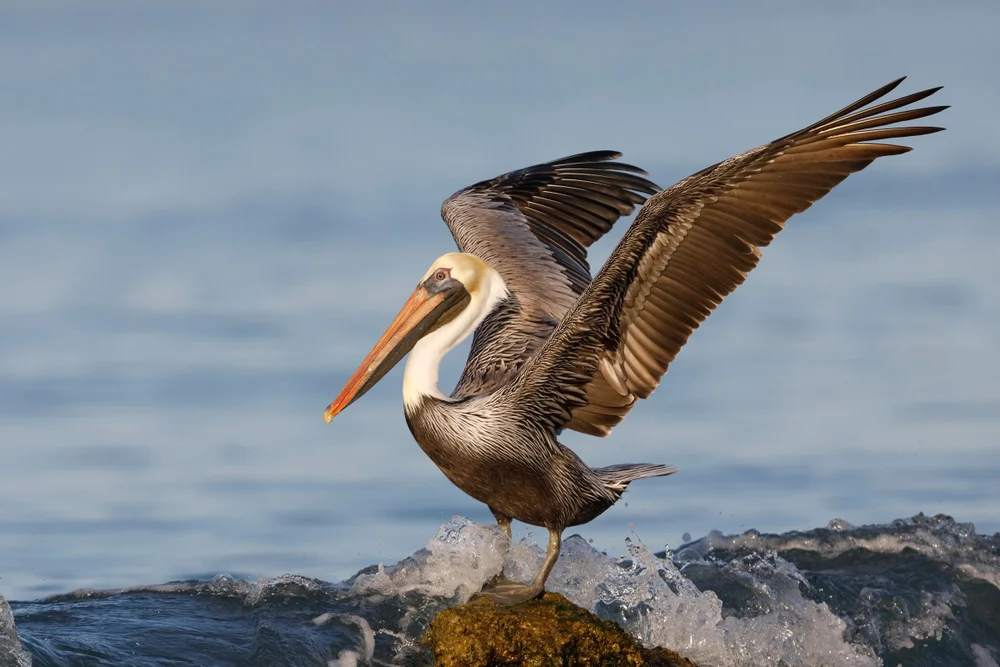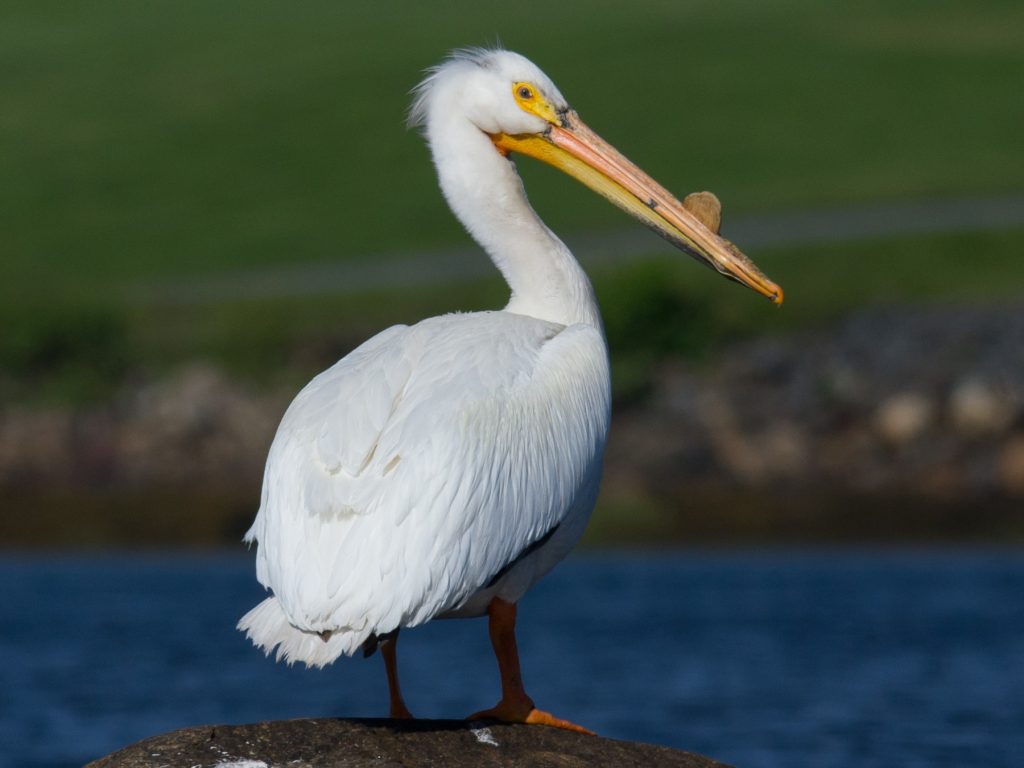Florida is home to both the Brown Pelican and the American White Pelican, which are two species of Pelican found in North America.
Throughout the year, the Brown Pelican can be observed in Florida, whereas the American White Pelicans are seasonal visitors during winter.
Pelicans are renowned for their massive bills, throat pouches, and feet, which contribute to their distinctive appearance. Despite their substantial size, they are surprisingly lightweight due to air pockets in their skeleton and skin, aiding in their ability to float. Additionally, their elongated wings assist in graceful soaring during flight.
There exist a total of eight pelican species worldwide, two of which reside in North America, namely the American White Pelican and the Brown Pelicans.
During the breeding season, the facial skin, throats, and bills of pelicans undergo vibrant color changes, and some individuals even develop additional features on their bills.
Pelicans form breeding colonies consisting of up to 50,000 birds. Depending on the species, these colonies may opt for ground or tree nesting. After approximately 25 days in the nest, the young pelicans assemble in groups called “creches” with up to 100 individuals. Astonishingly, the parents can identify and exclusively feed their own chicks.
While pelicans are predatory birds, they are not classified as raptors, which exclusively includes birds of prey. Pelicans primarily consume fish, although they may also indulge in crabs, frogs, snakes, mammals, birds, and insects.
Their throat pouches are employed for catching fish and draining the water before ingestion. Young pelicans also feed directly from their parents’ pouches.
To facilitate the identification of Pelicans found in Florida, this guide utilizes data collected from bird watchers on ebird and avibase to provide authentic information about the sightings of these birds.
2 Pelican Species in Florida:
Brown Pelican

Brown Pelicans can be observed year-round in Florida, predominantly along the coastal regions. Records indicate their presence in 14% of summer checklists and 19% of winter checklists submitted by bird watchers in the state.
Non-breeding adult Brown Pelicans typically possess white heads and necks with pale yellow foreheads. Their lengthy bills showcase a combination of yellow and orange hues. Their bodies exhibit a grayish-brown tone, complemented by short, black legs and webbed feet. Juveniles feature brown heads, necks, backs, and wings, with bluish-gray bills, and a light brown underside.
The Brown Pelican encompasses five subspecies, two of which breed in the United States. P.o.californicus represents the variant found along the Pacific Coast, while P.o.carolinensis populates the Atlantic Coast.
During the breeding season, distinctions between Pacific and Atlantic Brown Pelicans become more pronounced. Both species exhibit white heads with more vivid yellow foreheads. The nape of their necks transitions from white to dark brown. Atlantic Brown Pelicans possess olive-brown throat pouches, while their Pacific counterparts display red skin in this area.
- Pelecanus occidentalis
- Length: 48 – 50 inches (122 – 127 cm)
- Weight: 131.2 ounces (3718 g)
- Wingspan: 78 – 84 inches (198 – 213 cm)
Brown Pelicans either breed, migrate, or reside throughout the year along the Pacific and Atlantic Coasts of North America, extending to northern South America.
Brown Pelicans prefer habitats near shallow bodies of water. They are year-round inhabitants of estuaries and coastal marine environments, frequently found in mangrove islets, sandbars, breakwaters, and offshore rocks during resting periods.
A remarkable foraging ability distinguishes Brown Pelicans. They skillfully dive into deep ocean waters to secure their prey within their throat pouches. Upon resurfacing, they expel the water, enabling immediate ingestion of their catch.
Their diet primarily consists of fish such as sardines and herring. While not diving, they leisurely swim, utilizing their bills to seize prey. Additionally, they may consume crustaceans, frogs, eggs, and young birds.
Brown Pelican vocalizations: Adults generally remain silent, occasionally emitting a grunt, while juveniles vocalize to express food-related demands.
Brown Pelican nests are more commonly constructed on the ground rather than in trees. These nests are concealed and protected on islands, mangroves, and cliffs. The female builds the nest using reeds, leaves, pebbles, sticks, and soil. Both parents participate in incubating the two to four eggs for approximately one month.
Fun Fact: Brown Pelicans incubate their eggs by delicately covering them with their webbed feet. Unfortunately, the use of pesticides like DDT in the past resulted in thinning of the eggshells, making them susceptible to breakage under the weight of their parents’ feet. Extensive conservation efforts were necessary to restore the Brown Pelican population.
American White Pelican

American White Pelicans are commonly sighted in Florida during the winter months, spanning from November to March, although some individuals may remain throughout the year. Their presence is recorded in 1% of summer checklists and 8% of winter checklists.
These majestic birds are characterized by their large size and soaring ability, boasting the second-largest average wingspan among North American birds.
Non-breeding adult American White Pelicans exhibit a white plumage overall, with black flight feathers visible during flight or when their wings are spread. They possess bluish-gray eyes and yellow facial skin surrounding their eyes. Their bills, pouches, and feet display a pale orange hue. Juveniles feature light gray feathers with darker brown napes.
Breeding adults display distinctive coloring, deviating from the appearance of non-breeding individuals. They develop a yellow plate, resembling a horn, on their upper bills. While their bodies remain all-white, their eyes, bills, legs, and feet assume a brighter orange coloration.
American White Pelicans undergo several molting changes, referred to as the “eclipse” phase. During spring, a visible yellowish patch emerges on their breasts and chests, while blackish feathers appear on their heads in the summer.
- Pelecanus erythrorhynchos
- Length: 60 – 63 inches (152 – 160 cm)
- Weight: 246.4 ounces (6983 g)
- Wingspan: 96 – 110 inches (244 – 279 cm)
American White Pelicans breed in secluded inland lakes across North America before migrating to spend winters along the southern Pacific Coast of the United States, the Gulf of Mexico, Mexico, and Central America. During migration, they can be observed in western and central states of the US.
These birds primarily inhabit shallow freshwater lakes, wetlands, and the perimeters of lakes and rivers. In the winter, they can be found in coastal bays, inlets, and estuaries, where they forage in shallow water and rest on sandbars.
American White Pelicans predominantly feed on fish, skillfully capturing their prey using their immense bills. They often engage in cooperative foraging with other birds, employing strategic coordination to drive fish towards the shore, facilitating efficient scooping.
Furthermore, they exhibit opportunistic feeding behavior, venturing far distances in search of abundant feeding grounds. They may also consume crayfish, amphibians, salamanders, and are known to pilfer fish from the water’s surface, snatching them from other birds.
American White Pelican vocalizations: These birds typically remain silent, emitting only occasional
grunts. However, young individuals can be quite vocal within large colonies, expressing their food-related demands.
American White Pelican nests consist of simple, shallow depressions on the ground. Twigs, sticks, reeds, and other materials are added atop the soil to offer protection for the eggs.
The female then lays one to two eggs, which are incubated by both parents for up to thirty-six days. Unfortunately, due to siblicide (when one sibling kills the other), only one chick survives per nest.
Fun Fact: The elongated and enormous bill of the American White Pelican can hold up to three gallons of water. When capturing fish, they tilt their bills downward to drain the water, facilitating the swallowing of the remaining fish within their throat sacs.